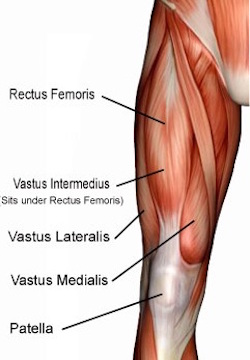
Your “Quads” (quadriceps) are actually a muscle group. They’re not just one muscle, but four muscles, each contributing to the extension of your knee joint and the flexing of your hip. The quad muscles are crucial in running, squatting and jumping.
The quads are anatomically located in the anterior (front) compartment of the thigh. The quad muscle group is made of up of three large muscles: vastus lateralis, vastus medialis, vastus intermedius, and the smaller rectus femorus. Vastus lateralis is on the outside of the thigh, medialis on the inside, rectus femoris is on top, and intermedius is in the center hidden below the rectus femoris.
The quadricep muscles originate at the ilium (upper part of your hip bone) and femur (thighbone) and come together in a tendon around your patella (kneecap) and then attach to your tibia (shinbone).


